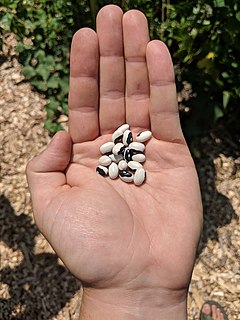
A bean is the seed of one of several genera of the flowering plant family Fabaceae, which are used as vegetables for human or animal food. They can be cooked in many different ways, including boiling, frying, and baking, and are used in many traditional dishes throughout the world.
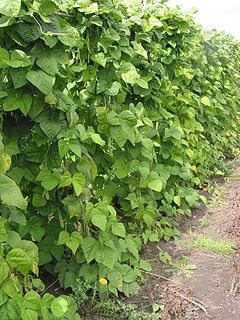
Phaseolus is a genus of herbaceous to woody annual and perennial vines in the family Fabaceae containing about 70 plant species, all native to the Americas, primarily Mesoamerica.
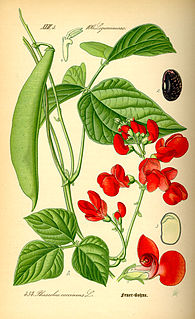
Phaseolus coccineus, known as runner bean, scarlet runner bean, or multiflora bean, is a plant in the legume family, Fabaceae. Another common name is butter bean, which, however, can also refer to the lima bean, a different species.

Phaseolus vulgaris, also known as the common bean and French bean, is a herbaceous annual plant grown worldwide for its edible dry seeds or unripe fruit. The main categories of common beans, on the basis of use, are dry beans, snap beans and shell (shelled) beans. Its leaf is also occasionally used as a vegetable and the straw as fodder. Its botanical classification, along with other Phaseolus species, is as a member of the legume family Fabaceae. Like most members of this family, common beans acquire the nitrogen they require through an association with rhizobia, which are nitrogen-fixing bacteria.
A bean is a large seed of several plants in the family Fabaceae, including the seed of the common bean.

Green beans are the unripe, young fruit of various cultivars of the common bean. Immature or young pods of the runner bean, yardlong bean, and hyacinth bean are used in a similar way. Green beans are known by many common names, including French beans, string beans, snap beans, snaps, and the French name haricot vert. They are also known as Baguio beans in Philippine English, to distinguish them from yardlong beans. Other locals in the vegetable farming regions of the Philippines refer these as "habitchuelas". It is commonly grown in the northern highlands of Benguet, Mountain Province and Nueva Vizcaya, and other mid-elevation areas in the country like Bukidnon, Quezon and Laguna.

The black turtle bean is a small, shiny variety of the common bean especially popular in Latin American cuisine, though it can also be found in the Cajun and Creole cuisines of south Louisiana. Like all varieties of the common bean, it is native to the Americas, but has been introduced around the world. It is also used in Indian cuisine, Tamil cuisine, where it is known as karuppu kaaramani and in Maharashtrian cuisine, where it is known as Kala Ghevada. The black turtle bean is often simply called the black bean, although this terminology can cause confusion with other black beans.
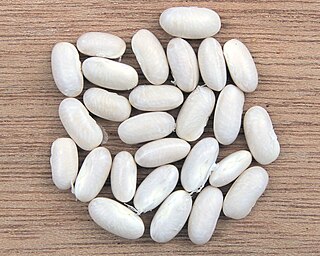
The navy bean, haricot, pearl haricot bean, Boston bean, white pea bean, or pea bean is a variety of the common bean native to the Americas, where it was first domesticated. It is a dry white bean that is smaller than many other types of white beans, and has an oval, slightly flattened shape. It features in such dishes as baked beans, various soups such as Senate bean soup, and even pies.
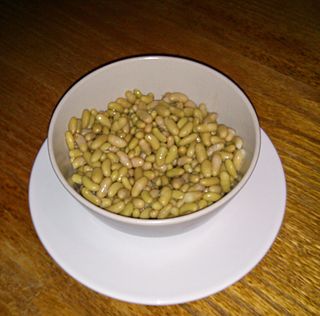
The flageolet bean is a variety of the common bean originating from France. The flageolet is picked before full maturity and dried in the shade to retain its green color. The bean is small, light green, and kidney-shaped. The texture is firm and creamy when shelled and cooked. The flageolet bean is commonly grown in the fertile soil of California.

Frijoles negros is a Latin American dish made with black beans, prepared in Guatemala, Cuba, Venezuela, Puerto Rico, Mexico, and other nations in Latin America. The black bean, a legume of the species Phaseolus vulgaris, is usually purchased in either canned or dried form. One cup of dried black beans yields approximately 2 1⁄2 cups of cooked beans. Black bean soup is another commonly prepared Cuban favorite.

Rice and beans is a type of dish made from a combination of staple foods in many cultures around the world. The grain and legume combination provides several important nutrients and many calories, and both foods are widely available. Rice and beans are vegan and, together, make up a complete protein. The beans are usually seasoned, while the rice may be plain or seasoned. The two components may be combined or served separately.
Colin Louis Avern Leakey was a leading plant scientist in the United Kingdom, a Fellow of King's College, Cambridge and of the Institute of Biology, and a world authority on beans.

Phaseolin is a prenylated pterocarpan found in French bean seeds and in the stems of Erythrina subumbrans.
The molecular formula C20H18O4 may refer to:
Phaseolin is the main reserve globulin in seeds of the French bean. It was named and first isolated and characterized by Thomas Burr Osborne in 1894.
Pea beans are several types of common food plants producing beans:

Rwira is an agricultural village in the Commune of Rutovu in Bururi Province in southern Burundi. It lies to the west of Rutovu. It is a place known for its bean production.
Rhizobium gallicum is a Gram-negative root-nodule bacterium. It forms nitrogen-fixing root nodules on legumes, being first isolated from those of Phaseolus vulgaris.
Soon Jai Park, Ph.D. (1937–2018) was a Canadian federal research scientist at Agriculture and Agri-Food Canada in Harrow, Ontario. He was internationally known for his dry bean breeding program that expanded bean production in Canada – taking beans that are usually grown in Africa, India, Korea, Japan and Brazil, and breeding them so they could thrive in Ontario and Western Canada to give farmers new crops to grow. He developed more than 28 bean varieties during his 25 year career
Phaseolus dumosus, the year bean or year-long bean, is an annual to perennial herbaceous vine in the family Fabaceae (legumes), native to a narrow region in the highlands of Guatemala. It is one of the five Phaseolus domesticates and is similarly used for its beans. It was recently found to be a hybrid between two other cultivated species of Central America, Phaseolus coccineus and P. vulgaris and displays intermediate characteristics. Taxonomically, it was previously categorized as Phaseolus polyanthus and P. coccineus ssp. darwinianus.











